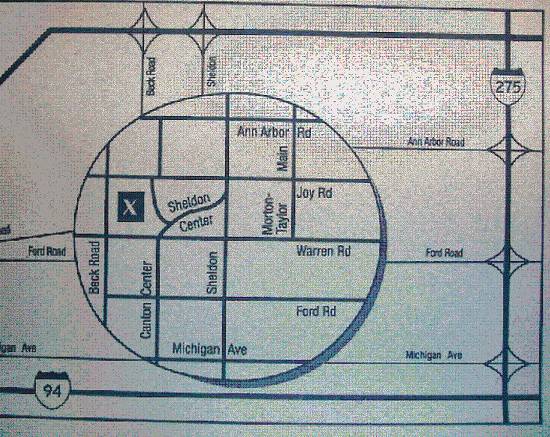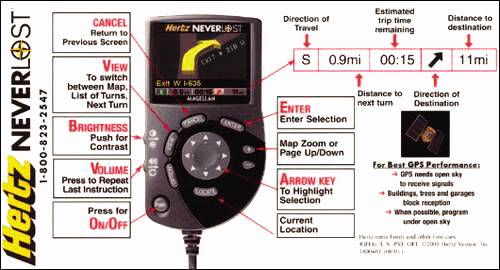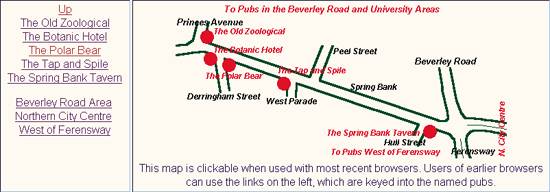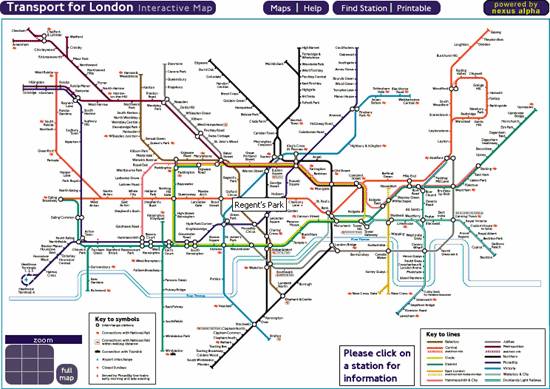Section 4.2. Wayfinding 2.0
4.2. Wayfinding 2.0Speaking of journeys, it should come as no surprise that wayfinding is among the most fertile soils for technologies of intertwinglement. For even as we advance into a connected century, we continue to spend great scads of time moving our physical bodies through space, and despite the ready availability of maps and street signs, we still manage to get ourselves lost. Lost in cities or inside buildings or on the way. One of my more memorable experiences happened a couple of years ago on the way to the doctor's office. You see, our youngest daughter was born with an underdeveloped tear duct system that failed to properly drain the lubricants of her eyes. She would often wake in the morning with one or both eyes sealed shut with guck (that's the technical term). Blocked tear ducts are a common problem in infants, but fortunately 90% of cases resolve themselves. Unfortunately, Claudia was in the 10% that require surgical probing, an outpatient procedure in which a blunt metal wire is inserted through the tear duct while the child lies wrapped in a blanket screaming bloody murder. Suffice it to say, my wife and I were not very happy as we piled into the minivan and headed for our visit with the pediatric ophthalmologist. And after 20 minutes of trying to reconcile our map, shown in Figure 4-2, with the territory, we were considerably less happy. So, we're late. We're lost. Claudia is presciently crying in the back seat. My wife is trying to decode the worse than useless map. And I'm calling the doctor's office on my cell phone to ask for directions while our minivan swerves violently through city streets. Figure 4-2. The map to the doctor's office This is the gritty reality of transmedia wayfinding at the dawn of the 21st century. Concrete mazes rendered barely navigable by the combination of lousy maps, illegible signs, missing landmarks, and desperate phone calls. Perhaps I exaggerate, but only to make an important point. Wayfinding remains an inefficient and even dangerous activity. At best, we waste time and endure needless stress. At worst, lives are lost when distracted drivers intertwingle their cars with immovable objects. There must be a better way, and fortunately we appear poised on the brink of breakthrough. After eons of bumbling around the planet, we're about to take navigation to a whole new level. Wayfinding 2.0. And it begins with location awareness. The crown jewel of next-generation wayfinding is the Global Positioning System (GPS), a satellite-based radionavigation system that enables land, sea, and airborne users to determine their three-dimensional position (latitude, longitude, altitude) and velocity from anywhere at any time. Compliments of the U.S. Department of Defense, 24 satellites orbiting 20,200 kilometers above the earth provide us with location awareness, accurate to within three meters. Equipped with a GPS receiver and map database, we can find our way like never before. In-car navigation systems like Hertz NeverLost , shown in Figure 4-3, are among the earliest mainstream applications. Select your destination from pre-programmed points of interest or enter an address or intersection, and they provide voice and visual turn-by-turn directions. These navigation systems are becoming increasingly accurate and affordable, and will eventually become user-friendly. Figure 4-3. The Hertz NeverLost navigation system Our kids will wonder how we ever survived without them, and not just in the car. GPS receivers grow smaller and more ubiquitous every year. Handheld units are increasingly common for hiking in natural and urban environments. Many runners now chart their course and track mileage using a GPS watch, like that in Figure 4-4. And a variety of GPS attachments are available for smartphones. I'm expecting my next Treo will come with embedded GPS. No more printed maps. No more getting lost on the way to the doctor. Of course, GPS isn't perfect. It doesn't actually work everywhere. Buildings, terrain, electronic interference, and sometimes even dense foliage can block signal reception. And for certain applications, such as wayfinding inside buildings, three meter accuracy isn't sufficient. For extreme ubiquity and precision, we will rely (like sea turtles and honeybees) on a composite of positioning approaches. Outdoors, receivers that combine GPS with complementary dead-reckoning technologies to estimate position by continuously tracking course, direction, and speed can handle the big picture. Figure 4-4. The Garmin Forerunner 201 GPS watch Indoors, and for any application in which extreme precision is required, we will depend on the location-sensing capabilities of other radiofrequency (RF) technologies such as Wi-Fi, Bluetooth, Ultra-wideband, and RFID. UWB, for example, is not just a standard for fast wireless communication. It just so happens that by calculating relative distances between nodes, UWB can achieve fine spatial resolution, identifying location to within one inch.
In considering potential applications of location-sensing technologies, it's important to recognize a few important distinctions beyond range and accuracy. First, there's the difference between physical position and symbolic location. GPS provides physical position such as 47°39'17" N by 122°18'23" W at a 20.5 meter elevation. A separate database or geographic information system is required to convert physical positions into symbolic locations such as in the kitchen, on the ninth floor, in Ann Arbor, next to a mailbox, or on an airplane approaching Amsterdam. Today's crude databases and flat map interfaces are insufficient for modeling the complexity of 3D urban environments. Similarly, there's the distinction between absolute and relative location. GPS receivers use latitude, longitude, and altitude to define a shared reference grid (absolute position) for all located objects. In relative systems, on the other hand, each object has its own frame of reference. For example, a receiver used in a mountain rescue effort indicates the relative location (direction and proximity) of an avalanche victim's transceiver. Finally, there are issues of recognition and privacy. Systems that perform localized location computation ensure privacy. In GPS, the receiving device computes its own position, and the satellites have no knowledge about who uses their signals. In contrast, active badge and RFID systems require the located object to self-identify so that position may be computed by the external infrastructure. In other words, navigation and surveillance can intertwingle. Technology architecture has social impact. But let's not wallow in privacy paranoia just yet. Why not dwell for a moment on the bright side of the big picture? The experience of becoming lost involuntarily is headed towards extinction. And our newfangled networked appliances promise all sorts of fascinating applications. Even before the widespread use of location-sensing technologies, wayfinding is being transformed by the Web. MapQuest and Google Maps provide coast-to-coast coverage, delivering maps and step-by-step driving directions to our computers and mobile phones. Google Local and Yahoo! Local enable the quick lookup of nearby businesses and services. Simply enter an address, city, or Zip Code to find a coffee shop, restaurant, movie theater, gas station, museum, or dentist near you. In merry old England, even the ancient tradition of wayfinding while intoxicated has been revolutionized by the Web, where countless web sites provide detailed maps for pub crawls of varying levels of difficulty. Pub crawl generators, like the one shown in Figure 4-5, make recommendations based on postal code, desired number of pubs, and the maximum distance between each pub. And on a more sober note, before visiting a hospital, shopping mall, or subway, we can grab a map from the web site, like that in Figure 4-6, and plan our trip from start to finish. Some bed and breakfasts even provide photos of each room, so we can see (and select) destinations from our point of origin. This brings new meaning to the experience of déjà vu. Researchers have begun to intertwingle these applications with location-aware devices. At IBM's Almaden Research Laboratory, for instance, Figure 4-5. A virtual pub crawl in Hull, England; http://www.eyorks.com/hullpub/ Figure 4-6. Interactive map of the London Underground J.C. Spohrer has advanced the notion of geocoding through the WorldBoard infrastructure:
We're still a head-mounted display away from fulfilling this vision of augmented reality in a mainstream sense. The technologies exist, but the costs remain prohibitive, for now. But that's not stopping us from transforming our world into a vast planetary chalkboard by annotating physical locations with virtual notes and images. These memes have long since escaped the laboratory and can be seen playing in the wild and on the Web. For instance, the Degree Confluence Project is collecting photographs and stories from all of the latitude and longitude integer degree intersections in the world: precise places in space, tagged with images and text, as shown in Figure 4-7. Anybody with a GPS receiver and a digital camera can contribute. Thus far, the collection boasts 40,000 photographs from 159 countries. So what is the purpose of this global database of images? Well, the stated goals include creating an organized sampling of the world and documenting the changes to these locations over time. But deep down, it's about experimentation and fun. It's about using technology to rediscover our natural world. In the words of one seeker:
A similar adventurous spirit infuses the sport of geocaching, a high-tech treasure hunting game for GPS users. In this game, people set up caches of maps, books, CDs, videos, pictures, money, jewelry, tickets, antiques, and other treasures. They then post the location coordinates on the Internet, and participants try to find the caches. The challenge derives from the distinction between knowing the location and reaching the location. Caches have been hidden on mountains, in trees, and even underwater. On any given day, geocaching.com lists over 100,000 caches in hundreds of countries. And, in anticipation of GPS-enhanced photography, Mappr , shown in Figure 4-8, is already tapping into the wealth of descriptive metadata supplied by Flickr users to match pictures to places. For now, Mappr's reliance on the uncontrolled, imprecise vocabulary of free tagging results in unreliable geographic data, but the maps sure are cool. These games spread like wildfire because they capture the imagination. They are harbingers of a new relationship with physical space. It's still early for mainstream applications, so we play our way into the future. That said, serious uses are beginning to take shape. The BrailleNote GPS , pitched as the Figure 4-7. A confluence in Japan; http://www.confluence.org Figure 4-8. Flickr's flowers on Mappr's map "Cadillac of Wayfinding Systems," enables people who are blind or visually impaired to more easily navigate unfamiliar areas. Drawing upon a massive points-of-interest database, blind pedestrians can locate a train station or bus stop, meet a friend for lunch at a new restaurant, or find their way back to a hotel. Independence through ubicomp. And in Europe, a smartphone software provider named Psiloc sells an application for defining location-based actions and events. Sleep-deprived commuters can set an alarm to wake them when their train approaches the station, even if it's ahead of schedule. If desired, an SMS message will automatically alert colleagues of your impending arrival. You can even use the Periodic SMS feature to provide family members with regular updates on your location. And all of a sudden, for better or for worse, we've once again dropped through the looking glass, for the same technology that helps us avoid getting lost can also help us be found. |
EAN: 2147483647
Pages: 87